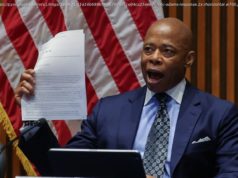The president has a very real reason for his unhappiness.
President Donald Trump is increasingly putting the blame on Senate Majority Leader Mitch McConnell for his complete lack of legislative victories so far this year.
On Thursday, the president told reporters that he was “very disappointed in Mitch, ” said that the Senate’s failure to pass a health bill by one vote was “a disgrace, ” and intimated that if the health, tax, or infrastructure bills all failed, the majority leader should perhaps step down.
And earlier in the week, Trump tweeted that McConnell should “get back to work” at passing his agenda, and complained the majority leader “screamed Repeal & Replace for 7 years” but “couldn’ t get it done.”
It was, however, McConnell who inadvertently kick-started this feud. “Our new president has of course not been in this line of work before, and I think had excessive expectations about how quickly things happen in the democratic process, ” McConnell said Monday.
According to CNN, this led to a call between McConnell and Trump Wednesday about the path forward on health care — a call that seems to have left the president unsatisfied. (“Obviously, there is some frustration, ” White House press secretary Sarah Huckabee Sanders said.)
Now, it’s not yet clear whether this week’s sniping will devolve into full-on conflict between the president and his party’s leadership in one chamber of Congress. McConnell has, after all, perfected the art of studiously ignoring Trump tweets. Trump could also realize that he has far more to lose than to gain from antagonizing McConnell and other Senate Republicans.
Still, Trump’s unhappiness here has a very real cause: As has happened with many prior presidents, his dreams of sweeping legislative wins have run up against the cold reality of the United States Senate. And his choice about how to deal with this will have major implications for his administration’s future.
Months ago, back before Donald Trump was sworn in as president, I argued that the US Senate would determine whether he’ d succeed or fail, legislatively.
So far, it’s made him fail.
The Republican majority in the House of Representatives has passed conservative bill after conservative bill — from the repeal and replacement of Obamacare to the repeal of Dodd-Frank to a series of deregulatory and tort reform bills to immigration enforcement bills — only to see them go nowhere in the Senate.
The biggest reason for this is the infamous Senate filibuster, which effectively requires a 60-vote supermajority to get a new bill through the chamber. Since Republicans only have 52 seats, that means they need to win over eight Democrats — a tall order for anything controversial. As a result, McConnell hasn’ t even bothered to take up most of those House-passed bills, since he knows they’ re doomed to defeat and would only waste precious Senate floor time.
But it’s not only about the filibuster. For nominations and other procedures that require a simple majority, Republicans have to hold 50 of their 52 senators together, which is itself a difficult task. And senators’ six-year terms make them less responsive to short-term political or presidential pressure.
For the health bill in particular, Republicans couldn’ t even get that majority needed for the special budget reconciliation process. McConnell’s final Hail Mary — a “skinny repeal” bill he begged his members to pass to keep the process alive — fell short because of three Republican defections. All of the more fleshed-out Republican health bills, however, were several more votes short even than that.
Overall, Trump has now spent more than seven months in office with no major legislative accomplishments to show for it, and the Senate is the main reason why. So for months, he’s called on the chamber to change its rules to eliminate the legislative filibuster, to no apparent avail. And now he’s turned his ire on McConnell personally.
As with any same-party president and Senate majority leader, Trump and McConnell have powerful incentives to work together rather than fight with each other — which, for much of the year, they’ ve managed to do.
Trump needs McConnell to get his nominees confirmed and to help him achieve legislative victories. McConnell wants Trump to keep representing Republican Party priorities in his choice of nominees and his agenda generally, and knows the president remains extremely popular among GOP base voters and in the conservative media.
Perhaps most importantly, the two men have linked electoral fortunes and both want the Republican Party to do well in the 2018 midterms — McConnell so he can keep his Senate majority, and Trump so his administration won’ t be dogged by Democrat-led investigations.
So McConnell has been extremely hesitant to criticize Trump this year — he often seems to be pretending he lives in a world in which Trump has no scandals and no Twitter account. Meanwhile, Trump has appointed McConnell’s wife, Elaine Chao, as secretary of transportation and has generally been happy to defer to McConnell’s seemingly superior wisdom on legislative matters. Life is easier for both of them if they’ re getting along.
And for now, despite these recent presidential tweets and statements, they still do appear to be mostly getting along. For instance, just days ago Trump did McConnell a solid by endorsing Luther Strange, the candidate McConnell strongly prefers in the Republican special election primary for Alabama’s Senate seat. And on Thursday afternoon, the White House appointed a former McConnell aide as chair of the Federal Energy Regulatory Commission.
But President Trump has, of course, proven willing to pick unwise political fights in the past, and may well do so here too by escalating this conflict further. Indeed, Politico’s Josh Dawsey reports that Trump seems increasingly willing to throw congressional Republicans under the bus in an attempt to preserve his “outsider” reputation — something that could prove disastrous for GOP base motivation in the 2018 midterms.
Now, longtime followers of Republican congressional dysfunction may be getting some déjà vu from all this, recalling how a small group of conservative critics in the House of Representatives forced Speaker John Boehner from office in 2015.
Yet something like that is far tougher to pull off in the Senate, because there’s a difference in how party leaders in each chamber are chosen.
The speaker of the House is elected by the full House of Representatives. Therefore, to win the position on the first ballot, a candidate generally needs overwhelming support from his or her own party (because the opposition party will vote against him or her) . As a result, a small group of defectors from the speaker candidate’s own party could block him or her from winning a majority.
The Senate majority leader, by contrast, is chosen in a closed-door, partisan election. Only the majority party votes in it. That means that a handful of defectors can’ t humiliate McConnell in a leadership election on the floor. Instead, more than half of his GOP senators would have to turn against him in private.






